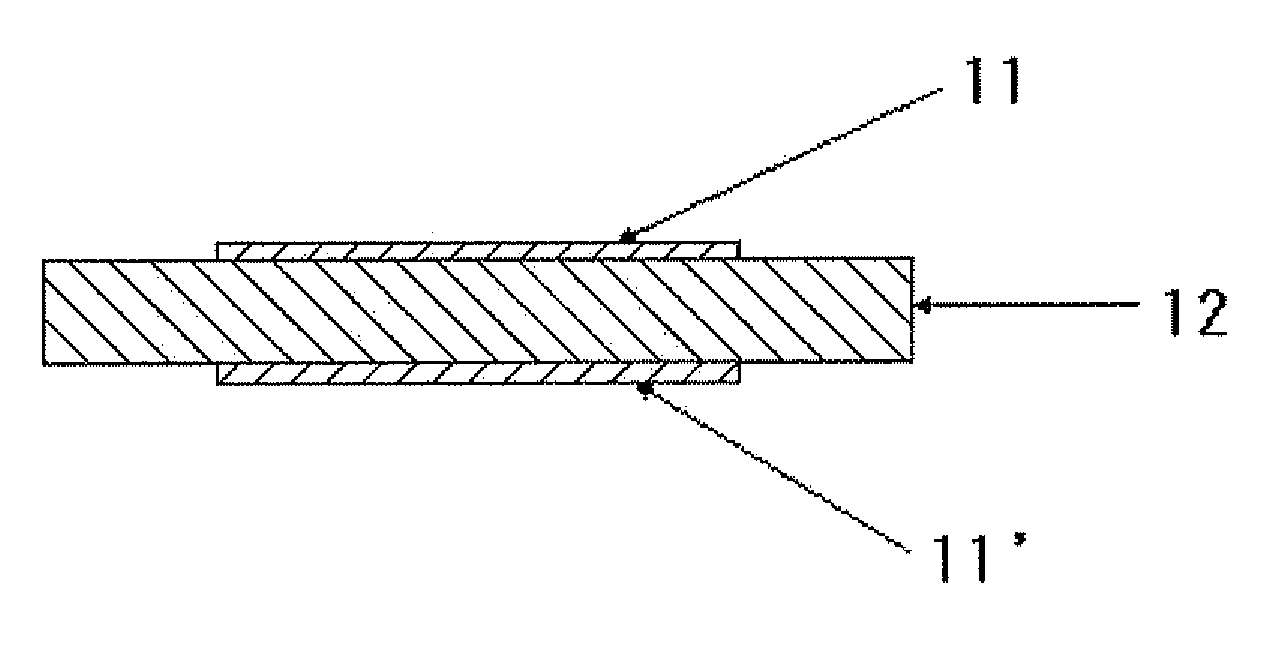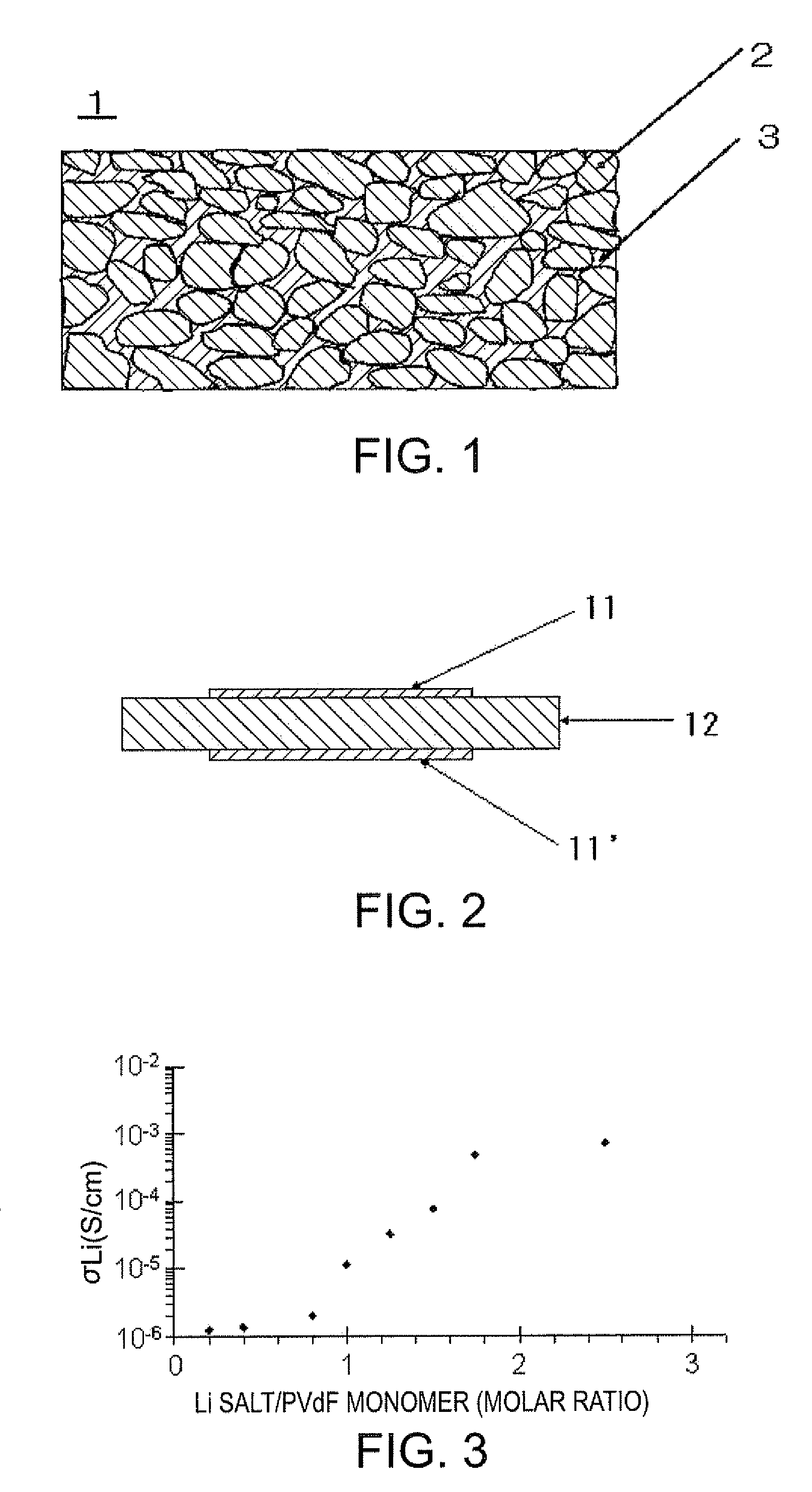Polymer solid electrolyte, method of production thereof, and lithium ion secondary battery
a solid electrolyte and lithium ion battery technology, applied in the direction of primary cells, non-aqueous electrolyte cells, electrochemical generators, etc., can solve the problems of inherently involving fire risk and dangerous liquids, and achieve excellent ion conductivity and sufficient strength
- Summary
- Abstract
- Description
- Claims
- Application Information
AI Technical Summary
Benefits of technology
Problems solved by technology
Method used
Image
Examples
example 1
[0064]A relationship between the inorganic oxide and the ion conductivity was examined in this Example and in Comparative Examples 1 to 6 described later. The polymer solid electrolyte layer was produced according to the following method.
[0065]A pellet-like polyvinylidene fluoride (available under a product name PVdF from Sigma-Aldrich Japan) was used as the ion conductive polymer. The pellet was dissolved in dimethylformamide to prepare a polymer solution. A 1 mol / L solution of the lithium electrolyte salt prepared by dissolving LiN(SO2C2F5)2 (Kishida Chemical Co., Ltd.) in ethylene carbonate was added and mixed with the polymer solution to obtain a mixed solution of the lithium electrolyte salt and the polymer. The lithium electrolyte salt was added in 2.5 times a molar quantity of a polyvinylidene fluoride monomer unit.
[0066]Subsequently, the anatase-type titanium oxide (Kanto Chemical Co., Inc) was ground with an agate mortar for at least 3 hours, and added to the mixed solution...
examples 2 to 5
[0074]In Examples 2 to 5, a relationship between different types of the ion conductive polymers and the ion conductivity was examined. The polymer solid electrolyte layer was produced according to the following method.
[0075]First, the following ion conductive polymers were prepared.
[0076]Example 2: PVdF (Sigma Aldrich Japan; product name, polyvinylidene fluoride; melting point 170° C.)
[0077]Example 3: PEO 4,000 (NOF Corporation; product name, polyethylene oxide; weight-average molecular weight 4,000; melting point 64° C.)
[0078]Example 4: PEO 60,000 (Sigma Aldrich Japan; product name, polyethylene oxide; weight-average molecular weight 60,000; melting point 66° C.)
[0079]Example 5: SBR (JSR; product name, styrene-butadiene rubber aqueous dispersion; melting point 120° C. (the upper limit temperature))
[0080]Note that the polyethylene oxide was prepared as a 10 mass % solution by being dissolved in diethyl carbonate (Kanto Kagaku).
[0081]LiN(SO2C2F5)2 was dissolved as the lithium electro...
example 6
[0085]In this Example, a relationship between an ion conductive polymer mixture ratio and the ion conductivity was examined.
[0086]A PVdF dimethylformamide solution was added to an anatase-type titanium oxide powder to make a PVdF concentration 2.5 to 20 mass %, and LiN (SO2C2F5)2 was added in 2.5 equivalents with respect to the monomer mole number. A system without PVdF was also prepared. A polymer dispersion so obtained was dried by being heated at 100° C. for about 5 hours under reduced pressure to remove a solvent, and a resulting solid was pulverized with an agate mortar. The pulverized particles were compression-molded at 620 MPa to produce a tablet-like polymer solid electrolyte layer (φ10.00 mm). The ion conductivity (lithium ion conductivity) of the polymer solid electrolyte layer was determined using the same measurement method used in Example 1. The results are presented in Table 3.
TABLE 3Lithium ionMixture ratioconductivity(mass %)(S / cm)0.01.03 × 10−82.52.95 × 10−55.06.99...
PUM
| Property | Measurement | Unit |
|---|---|---|
| melting point | aaaaa | aaaaa |
| melting point | aaaaa | aaaaa |
| temperatures | aaaaa | aaaaa |
Abstract
Description
Claims
Application Information
 Login to View More
Login to View More - R&D
- Intellectual Property
- Life Sciences
- Materials
- Tech Scout
- Unparalleled Data Quality
- Higher Quality Content
- 60% Fewer Hallucinations
Browse by: Latest US Patents, China's latest patents, Technical Efficacy Thesaurus, Application Domain, Technology Topic, Popular Technical Reports.
© 2025 PatSnap. All rights reserved.Legal|Privacy policy|Modern Slavery Act Transparency Statement|Sitemap|About US| Contact US: help@patsnap.com


